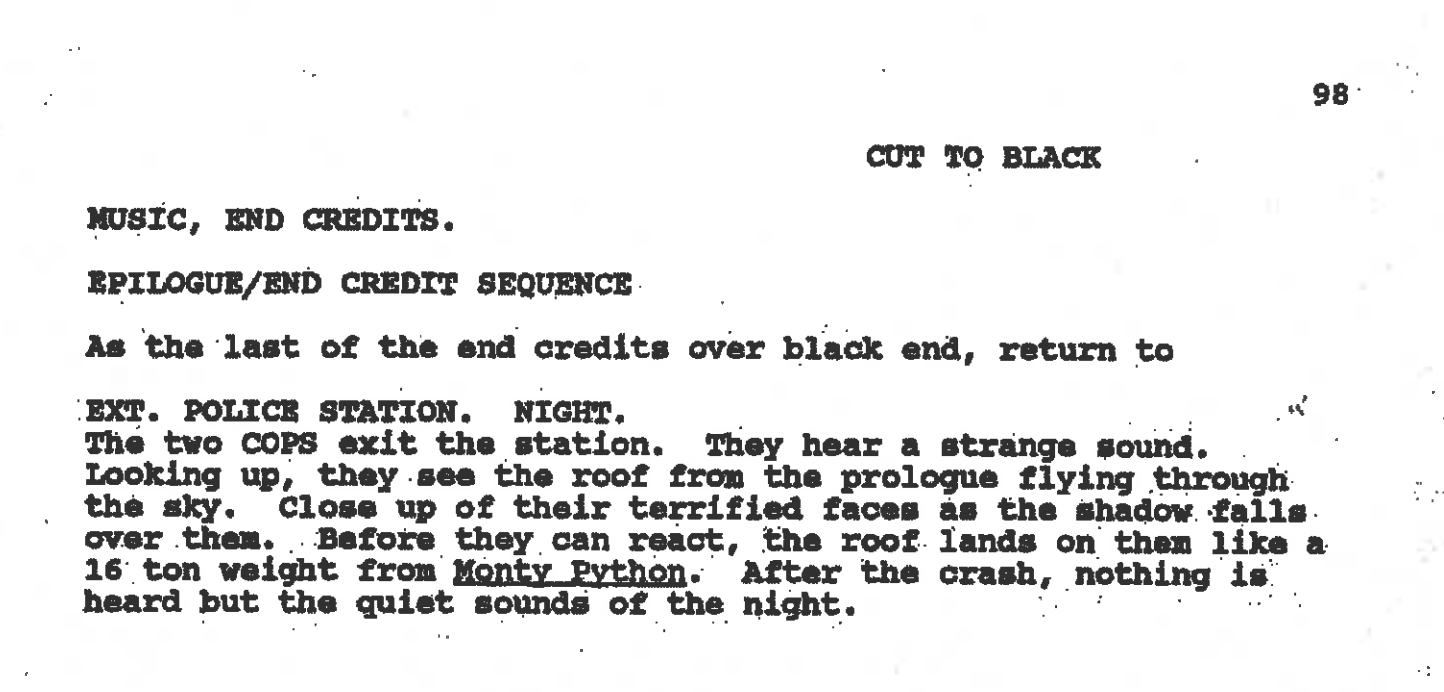WRITING YOUR SCREENPLAY WHILE SOCIAL DISTANCING: THE END
As the first post in this series began on page one, it feels natural for us to conclude with a look at “THE END.”
SPOILER ALERT: Do a quick scroll through this post. If you haven’t seen some of the movies listed, please know we’ll be discussing their endings. If you don’t want to ruin it for yourself, watch the movie before diving in.
People like to talk about happy endings and how viewers crave and love happy endings. We’re here to say: If anybody gives you this adage as a note, you have the WGF Librarians’ encouragement to question them.
Querying ourselves about some of our favorite endings, a movie that seems to come up again and again is My Best Friend’s Wedding.
What is it about this particular ending?
If you’ve seen it, you know the film ends with the protagonist, Julianne, giving the maid of honor speech at her BFF Michael’s wedding… on every level, putting his happiness ahead of her own. For the duration of the film, she’s pursued marrying him, but in the end… he marries another person.
Julianne lets him go. She does the right thing, sure, but—as she points out—she loses. Doing the right thing is good, but it doesn’t really make Julianne happy.
Life and movies are often about loss. Loss of a partner, friend, or protector. Loss of innocence. Loss of time. Loss of success or victory. Loss of the thing you thought you needed in order to be happy.
We find ourselves like Julianne, sitting alone at a wedding that is not ours, having experienced a painful loss.
But then our phone starts to ring…
And there’s our other best friend, George, who points out….
“There may not be marriage. There may not be sex, but BY GOD…”
(CUE THE MUSIC.)
“…there’ll be dancing!”
Maybe when people say that viewers crave happy endings, they really mean that viewers crave SATISFYING endings.
When we go through the major exercise in loss that we call LIFE, we want to be reminded of George. We want to be reminded of the things we STILL HAVE. At their core, that’s what stories give to us. They point out what remains.
If you read the draft of My Best Friend’s Wedding that exists out there on the web, you’ll see on the page that the ending is more or less there, but it doesn’t possess quite the same magic that it does in the final film. The idea is there, but it hasn’t been totally realized yet.
That’s the sentiment we’d like to leave you with here at the end of WRITING YOUR SCREENPLAY WHILE SOCIAL DISTANCING.
A screenplay is a blueprint, a map, a guidebook — often with a destination in mind, but as you move along towards that destination, the feeling might evolve. At its most transcendent, writing is about that very evolution and learning. Embrace it!
Now let’s look at a few more scripts.
BEAUTY AND THE BEAST (1991)
Screenplay by Linda Woolverton
Story by Roger Allers
Let’s call this ending a re-birth or restoration. The Beast loses his soul at the beginning of the film, but through self-sacrifice gains it back in the end, his transformation inspiring transformation all around him.
DEAD POETS SOCIETY (1989)
Written by Tom Schulman
The boys might lose their teacher, but he’s helped them gain their voices.
THE GRAPES OF WRATH (1940)
Screenplay by Nunnally Johnson
Based on the novel by John Steinbeck
The story ends the way it kicked off — the road. Many stories end on the road. The road is symbolic. Just because a story ends doesn’t mean that life stops. Despite losing everything again, the Joad family realizes their ability to keep going.
HOUSE PARTY (1990)
Written by Reginald Hudlin
The last image of this film is a great pay-off.
At the beginning of the movie, we see a group of teens with party music so loud and bumping, they literally blow the roof off the house. In a turn of poetic justice, at the end of the movie, the roof lands on the cops who have arrested and bullied the protagonists over the course of the film.
HUSTLERS (2019)
Written by Lorene Scafaria
This film ends with a metaphor, which asks spectators to look at what they just saw and think about where they fit within it.
INCEPTION (2010)
Written by Christopher Nolan
This ending is famously ambiguous, prompting an audience to leave the film in debate. Are we in reality or still in a dream?
PLANET OF THE APES (1968)
Screenplay by Michael Wilson and Rod Serling
Based on the novel The Monkey Planet by Pierre Boulle
Throughout this entire movie, the protagonists believe they’re on a distant planet…. The last page reveals, they’ve actually been on EARTH! It’s a TWIST ending where we, the audience, have been oblivious to the truth from the outset. In the end, we look at everything differently.
SOME LIKE IT HOT (1959)
Screenplay by Billy Wilder & I. A. L. Diamond
Based on the German film Fanfare of Love written by Robert Thoeren and M. Logan
And with the sentiments presented by Wilder and Diamond, we’ll end our series here. There’s much more to cover, but we’re going to get back to the small screen for a while. As always, if you have questions about scripts, formatting or anything else, you know where to find us via e-mail: library@wgfoundation.org.









